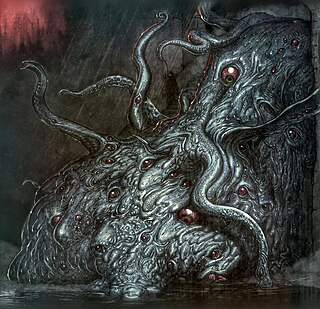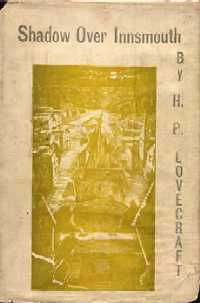
The Cthulhu Mythos is a shared fictional universe, originating in the works of American horror writer H. P. Lovecraft. The term was coined by August Derleth, a contemporary correspondent and protégé of Lovecraft, to identify the settings, tropes, and lore that were employed by Lovecraft and his literary successors. The name Cthulhu derives from the central creature in Lovecraft's seminal short story, "The Call of Cthulhu", first published in the pulp magazine Weird Tales in 1928.

Cthulhu is a fictional cosmic entity created by writer H. P. Lovecraft and first introduced in the short story "The Call of Cthulhu", published in the American pulp magazine Weird Tales in 1928. Considered a Great Old One within the pantheon of Lovecraftian cosmic entities, the creature has since been featured in numerous popular culture references. Lovecraft depicts Cthulhu as a gigantic entity worshipped by cultists. Cthulhu's appearance is described as looking like an octopus, a dragon, and a caricature of human form. Its name was given to the Lovecraft-inspired universe where it and its fellow entities existed, the Cthulhu Mythos.

"The Call of Cthulhu" is a short story by American writer H. P. Lovecraft. Written in the summer of 1926, it was first published in the pulp magazine Weird Tales, in February 1928.

Azathoth is a deity in the Cthulhu Mythos and Dream Cycle stories of writer H. P. Lovecraft and other authors. He is the ruler of the Outer Gods.
Nightgaunts are a fictional race in the Cthulhu Mythos and is also part of H. P. Lovecraft's Dream Cycle. The creatures appear in the poem "Night-Gaunts" and the novella The Dream-Quest of Unknown Kadath, both by Lovecraft.

A shoggoth is a monster in the Cthulhu Mythos. The beings were mentioned in passing in H. P. Lovecraft's sonnet cycle Fungi from Yuggoth (1929–30) and later described in detail in his novella At the Mountains of Madness (1931).

The Elder Things are fictional extraterrestrials in the Cthulhu Mythos. The beings first appeared in H. P. Lovecraft's novella, At the Mountains of Madness, and later appeared, although not named, in the short story "The Dreams in the Witch-House" (1933). Additional references to the Elder Things appear in Lovecraft's short story "The Shadow Out of Time" (1936).
"The Colour Out of Space" is a science fiction/horror short story by American author H. P. Lovecraft, written in March 1927. In the tale, an unnamed narrator pieces together the story of an area known by the locals as the "blasted heath" in the wild hills west of the fictional town of Arkham, Massachusetts. The narrator discovers that many years ago a meteorite crashed there, poisoning every living being nearby; vegetation grows large but foul tasting, animals are driven mad and deformed into grotesque shapes, and the people go insane or die one by one.

The Elder Sign is an icon in the Cthulhu Mythos, whose stories describe it as a form of protection against evil forces. Although not described in Lovecraft's work, he illustrated it in correspondence as a line with five branches. Mythos writer August Derleth described the Elder Sign as a warped, five-pointed star with a flaming pillar in its center, and it is this interpretation which has become the most popular in subsequent Mythos literature.

The Shadow over Innsmouth is a horror novella by American author H. P. Lovecraft, written in November–December 1931. It forms part of the Cthulhu Mythos, using its motif of a malign undersea civilization, and references several shared elements of the Mythos, including place-names, mythical creatures, and invocations. The Shadow over Innsmouth is the only Lovecraft story which was published in book form during his lifetime.
The Byakhee are a fictional race of interstellar beings in the Cthulhu Mythos.

"The Dunwich Horror" is a horror short story by American writer H. P. Lovecraft. Written in 1928, it was first published in the April 1929 issue of Weird Tales (pp. 481–508). It takes place in Dunwich, a fictional town in Massachusetts. It is considered one of the core stories of the Cthulhu Mythos.
Nodens is a fictional character in the Cthulhu Mythos. Based on the Celtic deity, Nodens, he is the creation of H. P. Lovecraft and first appeared in his short story "The Strange High House in the Mist" (1926).
"The Haunter of the Dark" is a horror short story by American author H. P. Lovecraft, written between 5-9 November 1935 and published in the December 1936 edition of Weird Tales. It was the last-written of the author's known works, and is part of the Cthulhu Mythos. The epigraph to the story is the second stanza of Lovecraft's 1917 poem "Nemesis".

Lovecraft Country is a term coined by Keith Herber for the New England setting, combining real and fictitious locations, used by H. P. Lovecraft in many of his weird fiction stories, and later elaborated by other writers working in the Cthulhu Mythos. The term was popularized by Chaosium, the producers of the Lovecraftian role-playing game Call of Cthulhu. Lovecraft scholar S. T. Joshi refers to the area as the "Miskatonic region", after its fictional river and university, while Lovecraft biographer Lin Carter calls it Miskatonic County, though Lovecraft indicates that at least some of his fictional towns were located in the real-life Essex County of Massachusetts.

The Whisperer in Darkness is a 26,000-word novella by American writer H. P. Lovecraft. Written February–September 1930, it was first published in Weird Tales, August 1931. Similar to The Colour Out of Space (1927), it is a blend of horror and science fiction. Although it makes numerous references to the Cthulhu Mythos, the story is not a central part of the mythos, but reflects a shift in Lovecraft's writing at this time towards science fiction. The story also introduces the Mi-go, an extraterrestrial race of fungoid creatures.

Lovecraft: A Look Behind the "Cthulhu Mythos" is a 1972 non-fiction book written by Lin Carter, published by Ballantine Books. The introduction notes that the book "does not purport to be a biography of H. P. Lovecraft", and instead presents it as "a history of the growth of the so-called Cthulhu Mythos."

Gary Clayton Myers is an American writer of fantasy and horror. He is a resident of Fullerton, California.
"To Mars and Providence" is a short story by American writer Don Webb, published in War of the Worlds: Global Dispatches. It is a conflation of The War of the Worlds, the Cthulhu Mythos, and the biography of H. P. Lovecraft.























